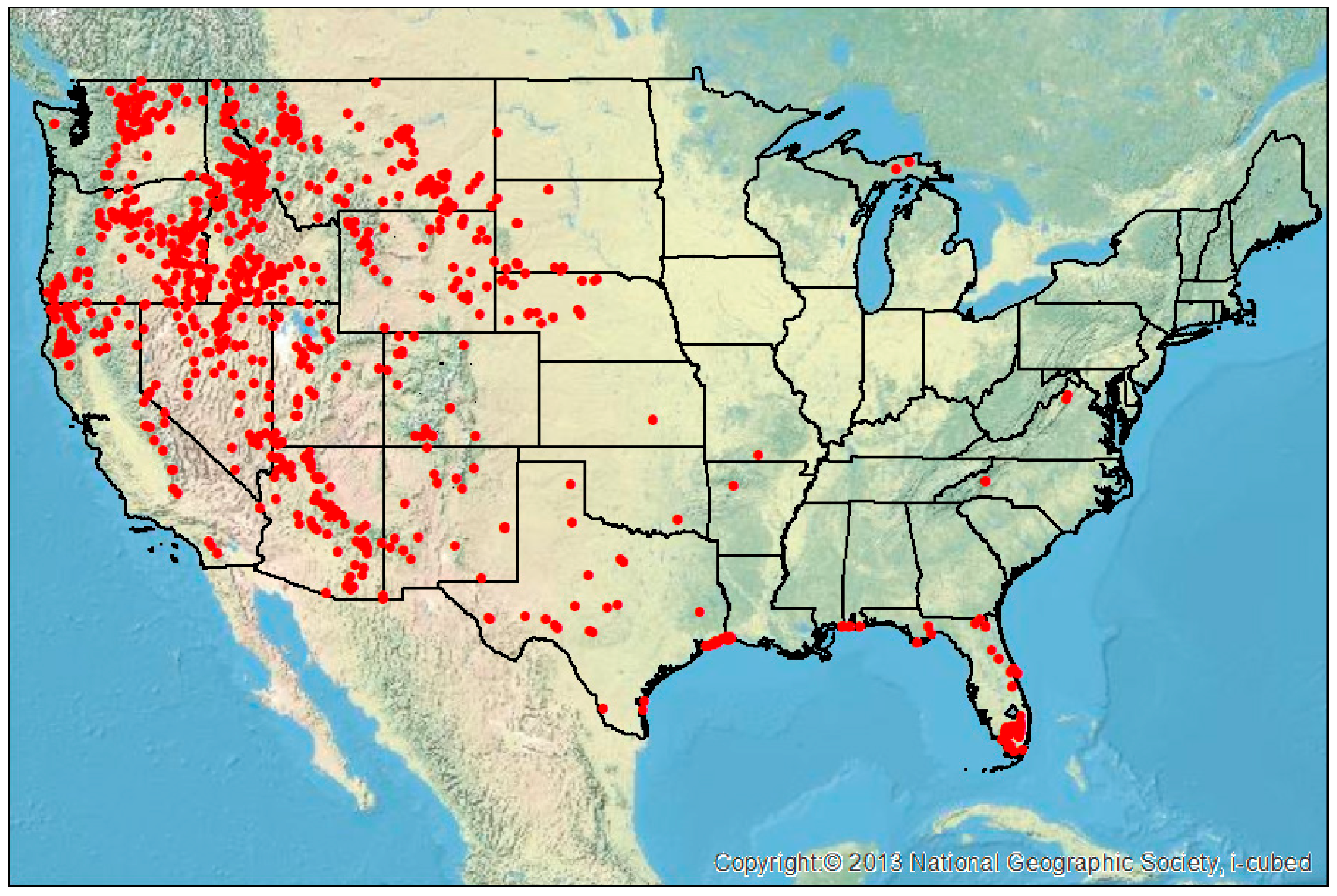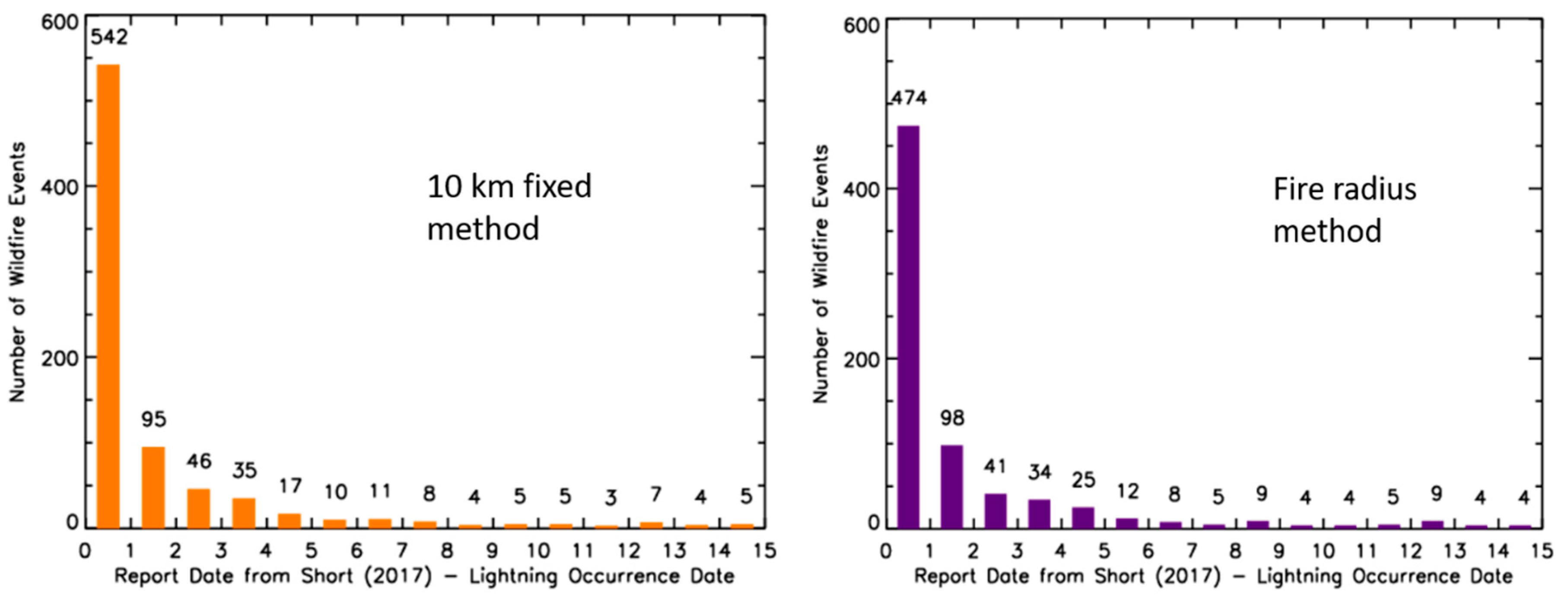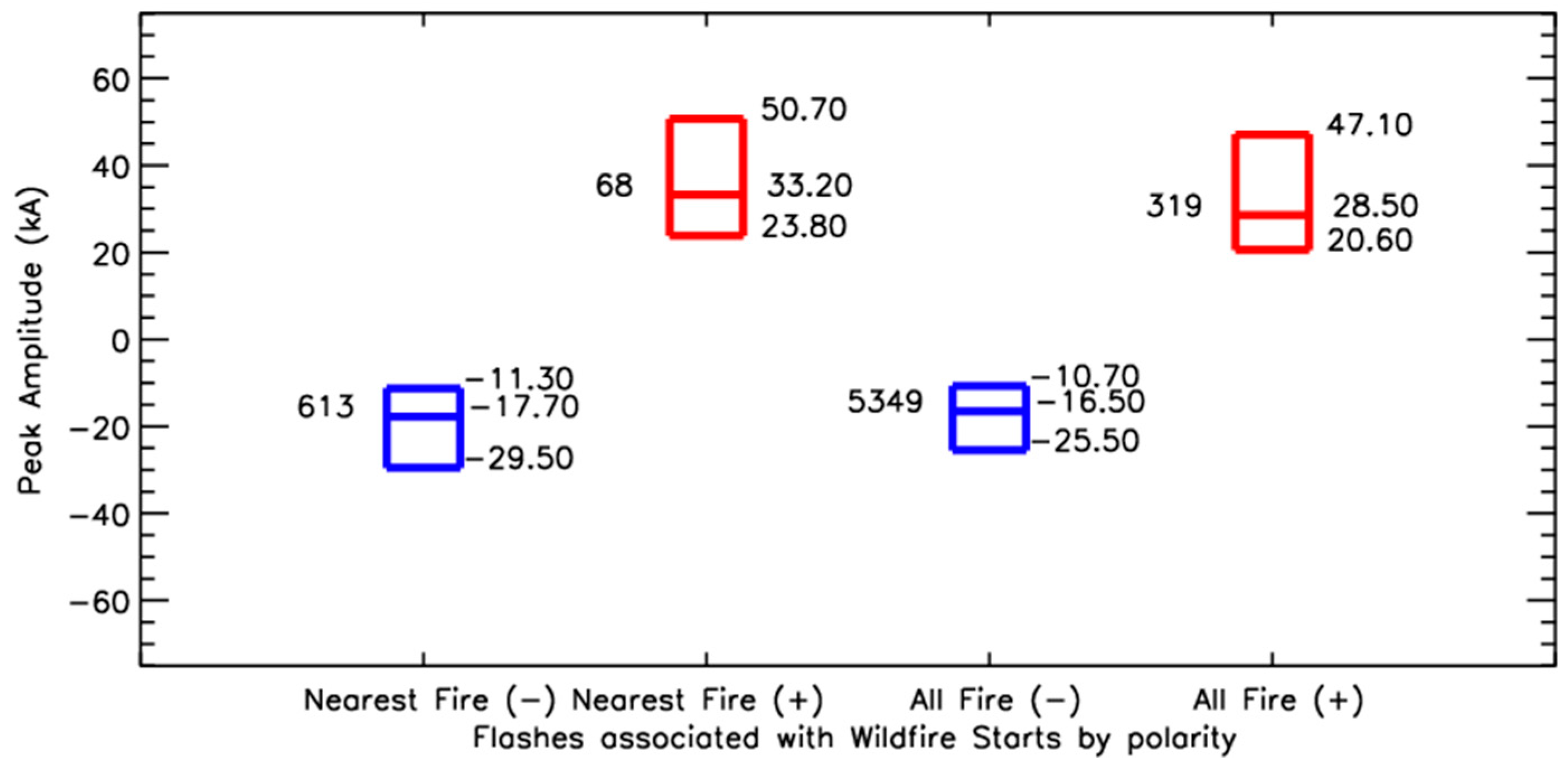Spatial, Temporal and Electrical Characteristics of Lightning in Reported Lightning-Initiated Wildfire Events
Abstract
:1. Introduction
- (1)
- Determine the number of reported lightning-initiated wildfires with burned acreage ≥4 km2 that have a corresponding lightning flash using multiple search radii methods.
- (2)
- Understand how flash classification (in cloud (IC) or cloud-to-ground (CG)) affects this association to wildfire.
- (3)
- Understand spatial and temporal differences between lightning flash location and wildfire start location.
- (4)
- Understand flash polarity, peak amplitude, multiplicity and flash density in the context of lightning flashes associated with lightning-initiated events.
- (5)
- Demonstrate how the lightning data can help determine the cause for wildfires with unknown or ambiguous origins.
2. Data and Methods
2.1. Data
2.1.1. Fire Database
2.1.2. National Lightning Detection Network (NLDN)
2.2. Data/Output Interrogation and Statistical Analysis
- (1)
- The wildfire report date and location was used to interrogate the NLDN flash data for the same date using six fixed search radii from the fire point. The fixed radii used were 10 km, 5 km, 2 km, 1 km, 500 m, and 250 m from the fire start location. These values were based on the 2 km search criteria employed in previous work [6], the median error of 500 m in the NLDN from prior to the 2003–2004 NLDN upgrade [29], the median error of 250 m cited in in most recent upgrade [27], the 90–95th observed location error of 5 km derived from observational studies [31], and an arbitrary 10 km to account for any large errors in wildfire initiation position.
- (2)
- If any lightning flash was observed within for the date and search radius, the date, time, peak current, multiplicity, distance to the fire start location and flash type (IC or CG) were recorded for each flash observed in the fixed search radius.
- (3)
- If a flash was not found, the previous day’s data were interrogated using the same search radius. This backward analysis continued until a flash was observed in the radius or the analysis went back a maximum of 14 days from the fire report date (Day 0 to Day minus 14).
- (4)
- If a flash was not observed in the 15-day period, a forward looking search was performed for one day in the event that the fire was misreported in time.
- (5)
- The start date of the wildfire report was then subtracted from the date of the closest lightning occurrence from the NLDN to determine the amount of time between the lightning occurrence and the wildfire start date within the USFS wildfire database. Any wildfire that occurred from day minus one (Day-1) to day minus 14 (Day-14) is considered a holdover event.
- (6)
- If no lightning was observed between Day+1 and Day-14, then the fire was marked as “no lightning found within 16 days and x km of fire start location.”
3. Results
3.1. Distribution of Distance between Lightning Flash and Fire Start Point
3.2. Distribution of Fires in Time
3.3. Flash Polarity, Peak Amplitude and Multiplicity
3.4. Flash Density
4. Discussion
4.1. Reasons for Lack of Lightning for Reported Lightning-Initiated Events
4.2. Holdover Fires
4.3. Fixed versus Fire Radius Search Methods
4.4. The Use of NLDN Flash Level Data Versus Stroke Level Data
5. Conclusions
- (1)
- Using the 2 km search radius [6], 60% of wildfires had at least one lightning flash within 2 km of the wildfire start location. The 10 km search radius yielded the highest number of reported lightning-initiated wildfires that contained a least one observed lightning flash. A total of 88% (797/905) of wildfire events had an IC or CG flash within the 15 day period and the 10 km search radius. However, the mean and 25th/75th percentile distances between the fire start location and the closest lightning flash in space were the largest of the search criteria and 63 of the lightning-wildfire pairs fell outside of the fire’s boundaries.
- (2)
- Using the fire’s radius as a search criteria, 81% of reported lightning-initiated events could be matched within 15 days of lightning-initiated wildfire report date. The median distance between the closest lightning flash and the fire start location was 0.83 km. The 75th percentile was 1.6 km and the 95th percentile distance was 5.86 km.
- (3)
- The largest percentage of lightning-initiated wildfires were reported on the same day as the lightning event. A total of 71% and 77% of wildfire events are reported within three days and seven of a lightning flash, respectively. Approximately ~1% of reported lightning initiated wildfires had the closest lightning flash the day after the reported ignition time.
- (4)
- Negative CG flashes accounted for 90% (613/681) of the closest lightning flashes to fire start locations. Forty-six percent of −CG flashes had a multiplicity of one. Positive CG flashes only accounted for 10% (68/681) of the CG flash population that was closest to the fire start location. Eighty percent (55/68) of +CG flashes had a multiplicity of 1. Peak amplitude was not observed to be statistically different between flashes closest to the fire and other lightning flashes within the fire footprint.
- (5)
- Flash densities were observed to be smaller than many of the metrics used for lightning-initiated wildfire forecasting (e.g., lightning activity level, lightning ignition efficiency). The majority of flash densities were less than 0.41 flashes km−2, which is far less than current lightning ignition efficiency metrics of several flashes per km2.
Author Contributions
Funding
Acknowledgments
Conflicts of Interest
References
- Balch, J.K.; Bradley, B.A.; Abatzoglou, J.T.; Nagy, R.C.; Fusco, E.J.; Mahood, A.L. Human-started wildfires expand the fire niche across the United States. Proc. Natl. Acad. Sci. USA 2017, 114, 1946–2951. [Google Scholar] [CrossRef]
- Williams, E.; Boldi, B.; Matlin, A.; Weber, M.; Hodanish, S.; Sharp, D.; Goodman, S.; Raghavan, R.; Buechler, D. The behavior of total lightning activity in severe Florida thunderstorms. Atmos. Res. 1999, 51, 245–265. [Google Scholar] [CrossRef]
- Trapp, R.J.; Wheatley, D.M.; Atkins, N.T.; Przybylinski, R.W.; Wolf, R. Buyer beware: Some words of caution on the use of severe wind reports in postevent assessment and research. Weather Forecast. 2006, 21, 408–415. [Google Scholar] [CrossRef]
- Duncan, B.W.; Adrian, F.W.; Stolen, E.D. Isolating the lightning ignition regime from a contemporary background fire regime in east-central Florida, USA. Can. J. For. Res. 2010, 40, 286–297. [Google Scholar] [CrossRef]
- Dowdy, A.J.; Mills, G.A. Atmosphere and fuel moisture characteristics associated with lightning-attributed fires. J. Appl. Meteorol. Climatol. 2012, 51, 2025–2037. [Google Scholar] [CrossRef]
- Nauslar, N.J. Examining the Lightning Polarity of Lightning Caused Wildfires. In Proceedings of the 23rd International Lightning Detection Conference, Tucson, AZ, USA, 18–19 March 2014. [Google Scholar]
- Sopko, P.; Bradshaw, L.; Jolly, M. Spatial products available for identifying areas of likely wildfire ignitions using lightning location data-Wildand Fire Assessment System (WFAS). In Proceedings of the 6th International Lightning Meteorology Conference, San Diego, CA, USA, 18–21 April 2016. [Google Scholar]
- Flannigan, M.D.; Wotton, B.M. Lightning-ignited forest fires in northwestern Ontario. Can. J. For. Res. 1991, 21, 277–287. [Google Scholar] [CrossRef]
- Lang, T.J.; Rutledge, S.A.; Dolan, B.; Krehbiel, P.; Rison, W.; Lindsey, D.T. Lightning in wildfire smoke plumes observed in Colorado during Summer 2012. Mon. Weather Rev. 2014, 142, 489–507. [Google Scholar] [CrossRef]
- Fuquay, D.M.; Baughman, R.G.; Taylor, A.R.; Hawe, R.G. Characteristics of seven lightning discharges that caused forest fires. J. Geophys. Res. 1967, 72, 6371–6373. [Google Scholar] [CrossRef]
- Fuquay, D.M.; Taylor, A.R.; Hawe, R.G.; Schmid, C.W., Jr. Lightning discharges that causes forest fires. J. Geophys. Res. 1972, 77, 2156–2158. [Google Scholar] [CrossRef]
- Fuquay, D.M. Positive cloud-to-ground lightning in summer thunderstorms. J. Geophys. Res. 1982, 87, 7131–7140. [Google Scholar] [CrossRef]
- Saba, M.M.F.; Pinto, O.; Ballarotti, M.G. Relation between lightning return stroke peak current and following continuing current. Geophys. Res. Lett. 2006, 33. [Google Scholar] [CrossRef]
- National Wildfire Coordination Group, 2016: Guide to Wildland Fire Cause and Determination. Technical Memo. Available online: http://www.nwcg.gov/ (accessed on 28 August 2017).
- Brook, M.; Kitagawa, N.; Workman, E.J. Quantitative study of strokes and continuing currents in lightning discharges to ground. J. Geophys. Res. 1962, 67, 649–659. [Google Scholar] [CrossRef]
- Kitagawa, N.; Brook, M.; Workman, E.J. Continuing currents in cloud-to-ground lightning discharges. J. Geophys. Res. 1962, 67, 637–647. [Google Scholar] [CrossRef]
- Livingston, J.M.; Krider, E.P. Electric fields produced by Florida thunderstorms. J. Geophys. Res. Oceans 1978, 83, 385–401. [Google Scholar] [CrossRef]
- Shindo, T.; Uman, M.A. Continuing current in negative cloud-to-ground lightning. J. Geophys. Res. Atmos. 1989, 94, 5189–5198. [Google Scholar] [CrossRef]
- Bitzer, P.M. Global distribution and properties of continuing current in lightning. J. Geophys. Res. Atmos. 2017, 122, 1033–1041. [Google Scholar] [CrossRef]
- Rakov, V.; Uman, M. Lightning: Physics and Effects; Cambridge University Press: New York, NY, USA, 2007. [Google Scholar]
- Wendler, G.; Conner, J.; Moore, B.; Shulski, M.; Stuefer, M. Climatology of Alaskan wildfires with special emphasis on the extreme year of 2004. Theor. Appl. Climatol. 2011, 104, 459–472. [Google Scholar] [CrossRef]
- Latham, D.J.; Schleiter, J.A. Ignition Probabilities of Wildland Fuels Based on Simulated Lightning Discharges; Res. Pap., INT-411; U.S Department of Agriculture, Forest Service, Intermountain Research Station: Ogden, UT, USA, 1989; p. 16.
- Hardy, C.C.; Menakis, J.P.; Schmidt, K.M.; Long, D.G.; Simmerman, D.G.; Johnston, C.M. Coarse-Scale Spatial Data for Wildland Fire and Fuel Management; Rocky Mountain Research Station: Fort Collins, CO, USA, 1999; Available online: http://www.fs.fed.us/fire/fuelman/ (accessed on 28 August 2017).
- Koshak, W.J.; Cummins, K.L.; Buechler, D.E.; Vant-Hull, B.; Blakeslee, R.J.; Williams, E.R.; Peterson, H.S. Variability of CONUS Lightning in 2003–12 and Associated Impacts. J. Appl. Meteorol. Climatol. 2015, 54, 15–41. [Google Scholar] [CrossRef]
- Medici, G.; Cummins, K.L.; Cecil, D.J.; Koshak, W.J.; Rudlosky, S.D. The intracloud lightning fraction in the Contiguous United States. Mon. Weather Rev. 2017, 145, 4481–4499. [Google Scholar] [CrossRef]
- Short, K.C. Spatial Wildfire Occurrence Data for the United States, 1992–2015 [FPA_FOD_20170508], 4th ed.; Forest Service Research Data Archive: Fort Collins, CO, USA, 2017. [CrossRef]
- Buck, T.; Nag, A.; Murphy, M.J. Improved Cloud-to-Ground and Intracloud Lightning Detection With the LS7002 Advanced Total Lightning Sensor. In Proceedings of the WMO Technical Conference on Meteorological and Environmental Instruments and Methods of Observation, Saint Petersburg, Russian, 7–9 July 2014; Available online: https://www.wmo.int/pages/prog/www/IMOP/publications/IOM-116_TECO-2014/Session%201/P1_9_Buck_TotalLightningSensor.pdf (accessed on 1 February 2019).
- Schultz, C.J.; Coy, J.J.; Case, J.L.; Hain, C.R. Land Surface and Lightning Characteristics Associated with Lightning-Initiated Wildfires. In Proceedings of the 42nd National Weather Association Annual Meeting, Garden Grove, CA, USA, 24 January 2017. [Google Scholar]
- Cummins, K.L.; Murphy, M.J. An overview of lightning location systems: History, techniques and data uses with an in-depth look at the U.S. NLDN. IEEE Trans. Electromagn. Compat. 2009, 51, 499–518. [Google Scholar] [CrossRef]
- Nag, A.; Murphy, M.J.; Schulz, W.; Cummins, K.L. Lightning locating systems: Insights on characteristics and validation techniques. Earth Space Sci. 2015, 2, 65–93. [Google Scholar] [CrossRef]
- Biagi, C.J.; Cummins, K.L.; Kehoe, K.E.; Krider, E.P. National Lightning Detection (NLDN) performance in southern Arizona, Texas and Oklahoma in 2003–2004. J. Geophys. Res. 2007, 112, D05208. [Google Scholar] [CrossRef]
- Fleenor, S.A.; Biagi, C.J.; Cummins, K.L.; Krider, E.P.; Shao, X.M. Characteristics of cloud-to ground lightning in warm-season thunderstorms in the Central Great Plains. Atmos. Res. 2009, 91, 33–352. [Google Scholar] [CrossRef]
- Wilks, D.S. Statistical Methods in the Atmospheric Sciences; Academic Press: Cambridge, MA, USA, 1995; p. 467. [Google Scholar]
- Fromm, M.; Lindsey, D.T.; Servranckx, R.; Yue, G.; Trickl, T.; Sica, R.; Doucet, P.; Godin-Beekmann, S. The untold story of pyrocumulonimbus. Bull. Am. Meteorol. Soc. 2010, 91, 1193–1210. [Google Scholar] [CrossRef]
- Dowdy, A.J.; Fromm, M.D.; McCarthy, N. Pyrocumulonimbus lightning and fire ignition on Black Saturday in southeast Australia. J. Geophys. Res. Atmos. 2017, 122, 7342–7354. [Google Scholar] [CrossRef]
- Rudlosky, S.D.; Fuelberg, H.E. Seasonal, regional and storm-scale variability of cloud-to-ground lightning characteristics in Florida. Mon. Weather Rev. 2011, 139, 1826–1843. [Google Scholar] [CrossRef]
- Calef, M.P.; Varvak, A.; McGuire, A.D. Differences in human versus lightning fires between urban and rural areas of the Boreal forest in Interior Alaska. Forests 2016, 8, 422. [Google Scholar] [CrossRef]
- Rudlosky, S.D.; Fuelberg, H.E. Pre- and postupgrade distributions of NLDN reported cloud-to-ground lightning characteristics in the contiguous United States. Mon. Weather Rev. 2010, 138, 3623–3633. [Google Scholar] [CrossRef]
- Thompson, K.B.; Bateman, M.G.; Carey, L.D. A comparison of two ground-based lightning detection networks against the satellite-based Lightning Imaging Sensor (LIS). J. Atmos. Ocean. Technol. 2014, 31, 2191–2205. [Google Scholar] [CrossRef]
- Rudlosky, S.D. Evaluating ENTLN performance relative to TRMM/LIS. J. Oper. Meteorol. 2015, 3, 11–20. [Google Scholar] [CrossRef]
- Bitzer, P.M.; Burchfield, J.C.; Christian, H.J. A Bayesian approach to assess the performance of lightning detection systems. J. Atmos. Ocean. Technol. 2016, 33, 563–578. [Google Scholar] [CrossRef]
- Saari, M.D.W.; Lawton, R.M.; Schultz, C.J.; Carey, L.D. Early characteristics of the polarimetric tornadic debris signature associated with the 20 May 2013 Newcastle–Moore, Oklahoma, tornado. J. Oper. Meteorol. 2014, 2, 110–114. [Google Scholar] [CrossRef]
- Cummins, K.L.; Murphy, M.J.; Bardo, E.A.; Hiscox, W.L.; Pyle, R.B.; Pifer, A.E. A combined TOA/MDF technology upgrade of the U.S. National Lightning Detection Network. J. Geophys. Res. 1998, 103, 9035–9044. [Google Scholar] [CrossRef]






| 10 km | 5 km | 2 km | 1 km | 0.5 km | 0.25 km | Fire Radius | |
|---|---|---|---|---|---|---|---|
| All Flashes | 88.07% | 76.69% | 59.56% | 39.67% | 23.43% | 7.51% | 81.33% |
| CG Only | 83.65% | 71.60% | 53.81% | 33.59% | 18.90% | 6.30% | 75.25% |
| Day | 10 km | 5 km | 2 km | 1 km | 0.5 km | 0.25 km | Fire Rad (IC+CG) | Fire Rad (CG only) |
|---|---|---|---|---|---|---|---|---|
| −14 | 0.55% | 0.22% | 0.00% | 0.00% | 0.00% | 0.00% | 0.44% | 0.33% |
| −13 | 0.44% | 0.33% | 0.00% | 0.00% | 0.00% | 0.00% | 0.44% | 0.22% |
| −12 | 0.77% | 0.44% | 0.22% | 0.22% | 0.11% | 0.11% | 0.99% | 0.88% |
| −11 | 0.33% | 0.11% | 0.11% | 0.00% | 0.00% | 0.00% | 0.55% | 0.55% |
| −10 | 0.55% | 0.11% | 0.00% | 0.00% | 0.00% | 0.00% | 0.44% | 0.44% |
| −9 | 0.55% | 0.22% | 0.00% | 0.00% | 0.00% | 0.00% | 0.44% | 0.44% |
| −8 | 0.44% | 0.44% | 0.33% | 0.22% | 0.22% | 0.00% | 0.99% | 0.66% |
| −7 | 0.88% | 0.33% | 0.33% | 0.11% | 0.00% | 0.00% | 0.55% | 0.44% |
| −6 | 1.22% | 0.99% | 0.33% | 0.11% | 0.00% | 0.00% | 0.88% | 0.22% |
| −5 | 1.10% | 0.88% | 0.66% | 0.11% | 0.00% | 0.00% | 1.33% | 0.88% |
| −4 | 1.88% | 1.66% | 1.44% | 0.99% | 0.77% | 0.11% | 2.76% | 2.54% |
| −3 | 3.87% | 2.98% | 2.21% | 1.77% | 0.88% | 0.33% | 3.76% | 3.43% |
| −2 | 5.08% | 4.09% | 2.76% | 2.21% | 1.10% | 0.55% | 4.53% | 3.87% |
| −1 | 10.50% | 9.39% | 7.51% | 4.97% | 3.31% | 0.22% | 10.83% | 10.17% |
| 0 | 59.89% | 54.48% | 43.65% | 28.95% | 17.02% | 6.19% | 52.38% | 50.17% |
| 1 | 3.76% | 7.29% | 7.07% | 5.41% | 3.20% | 1.44% | 1.10% | 1.10% |
© 2019 by the authors. Licensee MDPI, Basel, Switzerland. This article is an open access article distributed under the terms and conditions of the Creative Commons Attribution (CC BY) license (http://creativecommons.org/licenses/by/4.0/).
Share and Cite
Schultz, C.J.; Nauslar, N.J.; Wachter, J.B.; Hain, C.R.; Bell, J.R. Spatial, Temporal and Electrical Characteristics of Lightning in Reported Lightning-Initiated Wildfire Events. Fire 2019, 2, 18. https://doi.org/10.3390/fire2020018
Schultz CJ, Nauslar NJ, Wachter JB, Hain CR, Bell JR. Spatial, Temporal and Electrical Characteristics of Lightning in Reported Lightning-Initiated Wildfire Events. Fire. 2019; 2(2):18. https://doi.org/10.3390/fire2020018
Chicago/Turabian StyleSchultz, Christopher J., Nicholas J. Nauslar, J. Brent Wachter, Christopher R. Hain, and Jordan R. Bell. 2019. "Spatial, Temporal and Electrical Characteristics of Lightning in Reported Lightning-Initiated Wildfire Events" Fire 2, no. 2: 18. https://doi.org/10.3390/fire2020018
APA StyleSchultz, C. J., Nauslar, N. J., Wachter, J. B., Hain, C. R., & Bell, J. R. (2019). Spatial, Temporal and Electrical Characteristics of Lightning in Reported Lightning-Initiated Wildfire Events. Fire, 2(2), 18. https://doi.org/10.3390/fire2020018





